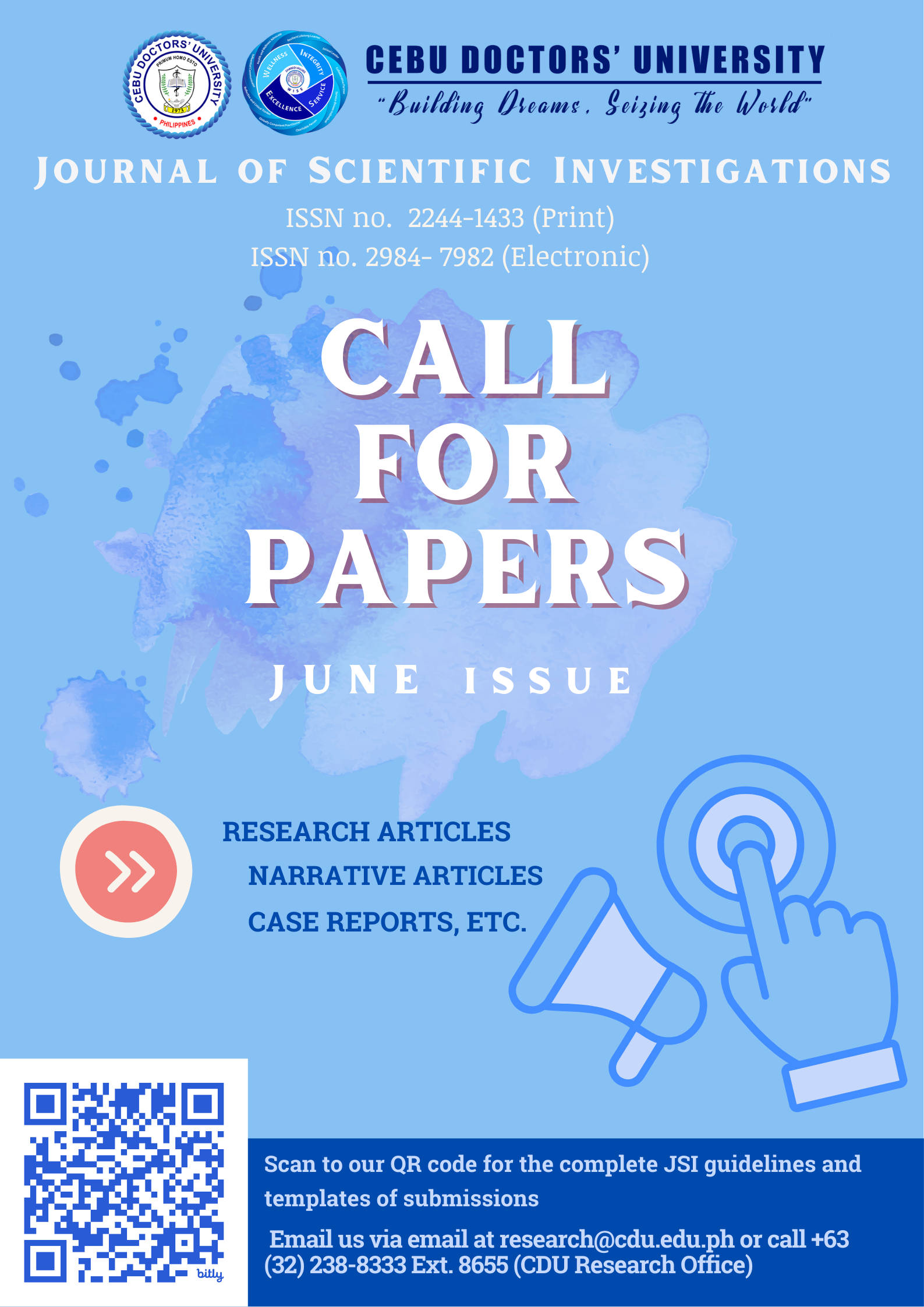The Antiseptic Potential of the Formulated Liquid Soap from the Methanolic Extract of Sepioteuthis lessoniana Ink against Staphylococcus aureus ATCC 25923
Keywords:
Antiseptic activity, contact time, Sepioteuthis lessoniana ink extract, Staphylococcus aureusAbstract
The majority of hospital-related infections worldwide are related to skin contact. In this study, the antiseptic potential of liquid soap from the methanolic extract of Sepioteuthis lessoniana ink against Staphylococcus aureus was determined. A non-randomized, controlled trial was done with positive control of Safeguard Liquid Hand Soap. The different concentrations (0.5% v/v, 1% v/v, and 5% v/v) of Sepioteuthis lessoniana ink extract soap were tested for their inhibitory activity. The Durham Tube Test was utilized to determine the antiseptic effect of the various concentrations, the minimum time for antiseptic effect to occur, and the corresponding efficacy of the commercial disinfecting agent. The study showed that all three experimental groups and the positive group inhibited the growth of the bacteria in as short as 5 minutes from contact with the bacteria. Safeguard Liquid Hand Soap which contains the active ingredient 0.5% chloroxylenol and the lowest formulation of 0.5% v/v concentration of Sepioteuthis lessoniana ink extract liquid soap exhibited similar results during the experiment. Therefore, formulated soap from the ink extract of Sepioteuthis lessoniana demonstrated antiseptic properties that are comparable to that of Safeguard Liquid Hand Soap.
References
Adalbert, J. R., Varshney, K., Tobin, R., & Pajaro, R. (2021). Clinical outcomes in patients co-infected with COVID-19 and Staphylococcus aureus: A scoping review. BMC Infectious Diseases, 21(1). https://doi.org/10.1186/s12879-021-06616-4
Anvarsha, N., & Kalyani, P. (2021). A phytomass-inspired carbon and its importance as an antibacterial agent against human pathogens. Future Journal of Pharmaceutical Sciences, 7(1). https://doi.org/
1186/s43094-021-00195-6
Basnet, A. (2020, April 4). Xanthoproteic test: Principle, reaction, reagents, procedure and result interpretation. Online biochemistry notes. http://biocheminfo.com/2020/04/04/xanthoproteic-test-principle-reaction-reagents-procedure-and-result-interpretation/
Bednarek, R. S., Nassereddin, A., & Ramsey, M. L. (2023, May 29). Skin antiseptics. StatPearls Publishing. https://www.ncbi.nlm.nih.gov/books/NBK507853/
Bhagya. (2018, October 11). Tests for the functional groups present in organic compounds. Learn CBSE. https://www.learncbse.in/tests-for-the-functional-groups-present-in-organic-compounds/
Binsi, P. K., & Zynudheen, A. A. (2019). Functional and nutraceutical ingredients from marine resources. In A. M. Grumezescu & A. M. Holban (Eds.), Value-added ingredients and enrichments of beverages, (pp. 101-171). Elsevier. https://doi.org/10.1016/b978-0-12-816687-1.00004-7
Chandran, S., Avari, M., Cherian, B. P., Suarez, C. (2021). Covid-19-associated Staphylococcus aureus cavitating pneumonia. BMJ Case Reports, 14(6). https://doi.org/10.1136/bcr-2021-243726
Chiang, C.-I., Chung, M.-T., Shiao, J.-C., Wang, P.-L., Chan, T.-Y., Yamaguchi, A., & Wang, C.H. (2020). Seasonal movement patterns of the Bigfin Reef Squid Sepioteuthis lessoniana predicted using statolith δ18o values. Frontiers in Marine Science, 7. https://www.frontiersin.org/articles/10.3389/fmars.2020.00249/full
Das, B. K., Al-Amin, M. M., Russel, S. M., Kabir, S., Bhattacherjee, R., & Hannan, J. M. A. (2014). Phytochemical screening and evaluation of analgesic activity of Oroxylum indicumz. Indian Journal of Pharmaceutical Sciences, 76 (6), 571-575. https://www.ncbi.nlm.nih.gov/pmc/articles/PMC4293694
Hartline, R. (2023, July 1). Microbiology laboratory manual. Biology LibreTexts. https://bio.libretexts.org/Bookshelves/Microbiology/Microbiology_Laboratory_Manual_(Hartline)/01%3A_Labs/1.22%3A_Fermentation
Hossain, M. P., Rabeta, M. S., & Husnul Azan, T. (2019). Medicinal and therapeutic properties of cephalopod ink: A short review. Food Research, 3(3), 188–198. https://doi.org/10.26656/fr.2017.3(3).201
Jeyasanta, I., & Patterson, J. (2020). Bioactive properties of ink gland extract from squid Loligo duvauceli. Ecologia, 10 (1), 9-19. https://doi.org/10.3923/ecologia.2020.9.19
Jismi, J., Krishnakumar, K., & Dineshkumar, B. (2018). Squid ink and its pharmacological activities. GSC Biological and Pharmaceutical Sciences, 2(3), 017–022. https://doi.org/10.30574/gscbps.2018.2.3.0013
Karki, G. (2018, December 18). Millon’s test: Objective, principle, reagents, procedure and result. Online Biology Notes. https://www.onlinebiologynotes.com/millons-test-objective-principle-reagents-procedure-and-result/
Kwiecinski, J. M., Horswill, A. R. (2020). Staphylococcus aureus bloodstream infections: Pathogenesis and regulatory mechanisms. Current Opinion in Microbiology, 53, 51-60. https://pubmed.ncbi.nlm.nih.gov/32172183/
Nadarajah, S. K., Vijayaraj, R., & Mani, J. (2017). Therapeutic significance of Loligo vulgaris (Lamarck, 1798) ink extract: A biomedical approach. Pharmacognosy Research, 9(Suppl 1), S105-S109. https://www.ncbi.nlm.nih.gov/pmc/articles/PMC5757319/
National Institutes of Health. (2023, March 6). Safeguard antibacterial hand wash notes of aloe- chloroxylenol soap. DailyMed. https://dailymed.nlm.nih.gov/dailymed/drugInfo.cfm?setid=f63c0d41-5034-1cdf-e053-2995a90aa56e&audience=professional
Nicomrat, D., & Tharajak, J. (2015). Antimicrobial effect of squid ink on common microbial causing biofilm attaching to silicone. Applied Mechanics and Materials, 84, 191-194. https://doi.org/10.4028/www.scientific.net/amm.804.191
Ramasamy, P., Subhapradha, N., Srinivasan, A., Shanmugam, V., Krishnamoorthy, J., & Shanmugam, A. (2011). In vitro evaluation of antimicrobial activity of methanolic extract from selected species of cephalopods on clinical isolates. African Journal of Microbiology Research, 5(23), 3884-3889. https://doi.org/10.5897/AJMR11.564
Runck, A. (2021, September 29). Bigfin reef squid. The Australian Museum. https://australian.museum/learn/animals/molluscs/bigfin-reef-squid-sepioteuthis-lessoniana-lesson-1830/
Rutala, W. A., & Weber, D. J. (2013). Disinfectants used for environmental disinfection and new room decontamination technology. American Journal of Infection Control, 41(5), S36-S41. https://doi.org/10.1016/j.ajic.2012.11.006
Sajed, A. N., Shagufta, Haider, S., Yousaf, N. W., Ali, I. A. S., & Imran, S. (2014). Antibacterial activity of liquid hand washes against daily encounter bacteria. IOSR Journal of Pharmacy, 4(2), 19-23. http://www.iosrphr.org/papers/v4i02/Version-1/D0421019023.pdf
Singh, B. (2023, April 10). Ferric chloride formula, solution preparation and ferric chloride test. Chemicals Learning. https://www.chemicalslearning.com/2023/04/ferric-chloride-formula-solution.html.
Whalen, K., Finkel, R., & Panavelil, T. A. (Eds.). (2015). Lippincott illustrated reviews: Pharmacology (6th ed.). Wolters Kluwer
Downloads
Published
How to Cite
Issue
Section
License
Copyright (c) 2023 Kenrie Durangparang, Zuriel Jesabel B. Cuyos, Berlene Gail H. Lama, Krystiel Ericka Z. Malusay, Dea Chizly B. Yap, Kevin Christian Dela Cruz

This work is licensed under a Creative Commons Attribution-NonCommercial 4.0 International License.
Authors retain copyright and grant the journal right of first publication with the work simultaneously licensed under a Creative Commons Attribution-Non-Commercial 4.0 International License that allows others to share the work with an acknowledgment of the work's authorship and initial publication in this journal. Readers can freely access and download the PDF, but for non-commercial purposes only and should not be used for monetary purposes.




